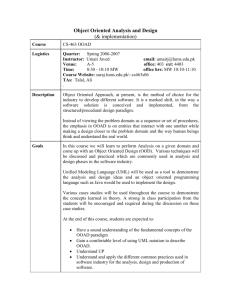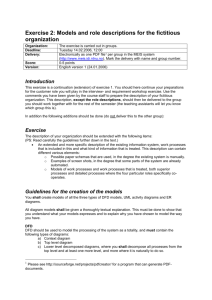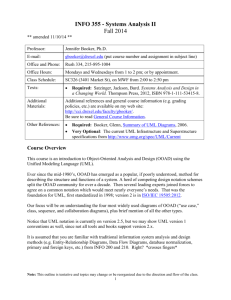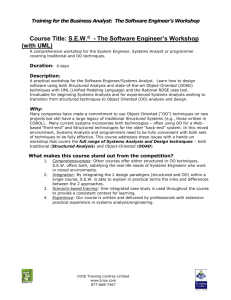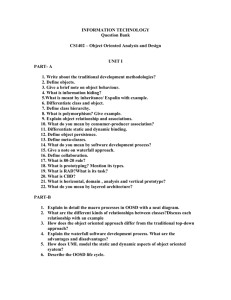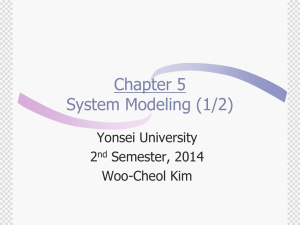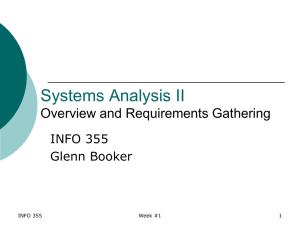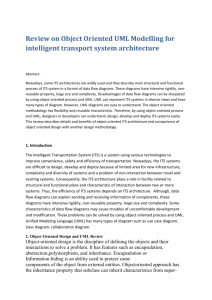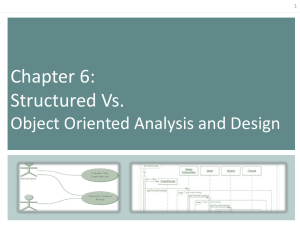SAD vs OOAD: Structured & Object-Oriented Analysis & Design
advertisement
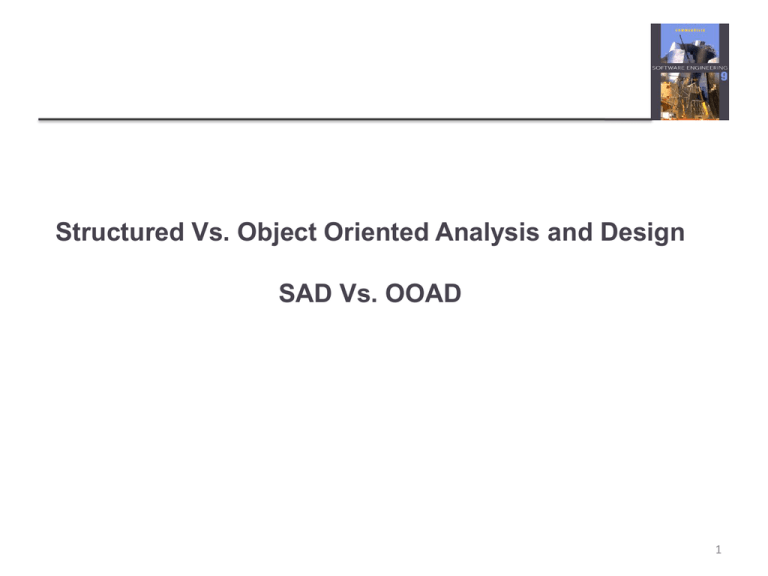
Structured Vs. Object Oriented Analysis and Design SAD Vs. OOAD 1 Software process model Requirements Specification Design and Implementation Validation Evolution 2 Modeling A model is an abstract view of a system We create a model to gain better understanding of an entity, for example a model of a plane is a small plane. When the entity is software, the model takes a different form. 3 A software Model A software model must be capable of representing : the information that the software transforms, the functions that enable the transformation to occur, and the behavior of the system as the transformation takes place. Two types of software modeling (requirements): Structured model Object oriented model 4 Structured Analysis Vs. Object Oriented Modeling Structured Analysis and Object Oriented Analysis are different techniques of developing a computer system. Structured analysis: the focus is only on process and procedures. Modeling techniques used in it are DFD(Data Flow Diagram), Flowcharts etc. Object oriented analysis: the focus is more on capturing the real world objects in the current scenario that are of importance to the system. It stresses more on data structure and less on procedural structure. Modeling techniques used in it are UML(Unified modeling Language), that can present both structural and behavioral/procedural aspect of the system. UML includes Class Diagram, State Diagram, Use case diagram, Sequence Diagram, etc. Chapter 5 System modeling 5 Structures Analysis and Design SAD 6 Structured analysis and design Analysis Determine system requirements Structuring system process requirements Logical requirements (logical modeling) Structuring system data requirements Design Database design (DB normalization) Forms and report design (GUI design) Chapter 5 System modeling 7 Analysis: Structured analysis and design Determine system requirements: Interviewing individuals and/or group Structuring system process requirements Data flow diagrams (DFD) - process modeling Context diagram Process decomposition (DFD levels): 4 types of DFD: • Current physical: adequate detail only • Current logical: enables analysts to understand current system • New logical: technology independent, show data flows, structure, and functional requirements of new system. • New physical: technology dependent. Logical modeling: using structured English, decision table/tree Structuring system data requirements: using ER diagram Chapter 5 System modeling 8 DFD symbols Chapter 5 System modeling 9 Context diagram Chapter 5 System modeling 10 Level-0 diagram Chapter 5 System modeling 11 Design: Structured analysis and design Database design (DB normalization): Converting complex data structures into simple, stable data structures. The result of normalization is that every non-primary key attribute depends upon the whole primary key. Forms and report design (GUI design) Chapter 5 System modeling 12 Object Oriented Analysis and Design OOAD 13 Object-Oriented Analysis and Design (OOAD) Based on objects rather than data or processes. Object: is a structure encapsulating attributes and behaviors of real-world entity. Object class: is a logical grouping of objects sharing the same attributes and behaviors. Inheritance: is hierarchical arrangement of classes enable subclasses to inherit properties of superclasses. Chapter 5 System modeling 14 Object-Oriented Analysis and Design (OOAD) phases: Analysis : Structuring requirements (Use cases) Conceptual data modeling (class diagram) Object relationship modeling: Class diagram (ER diagram) Analysis classes: Sequence diagram – activity diagram – state diagram Design : Physical DB design Design elements: classes – components – system architecture GUI design Chapter 5 System modeling 15 Commonly used UML diagram types 1. Activity diagrams, which show the activities involved in a process or in data processing . 2. Use case diagrams, which show the interactions between a system and its environment. 3. Sequence diagrams, which show interactions between actors and the system and between system components. 4. Class diagrams, which show the object classes in the system and the associations between these classes. 5. State diagrams, which show how the system reacts to internal and external events. 16 Interaction models : Use case A use case in the MHC-PMS 17 Structural models : Class diagrams An association is a link between classes that indicates that there is some relationship between these classes. When you are developing models during the early stages of the software engineering process, think of objects represent something in the real world, such as a patient, a prescription, doctor, etc. 18 Ex: Classes and associations in the MHC-PMS 19 Ex: The Consultation class 20 Behavioral models A- Data-driven modeling – Activity diagram Behavioral models are models of the dynamic behavior of a system as it is executing. They show what happens or what is supposed to happen when a system responds to a stimulus from its environment. Many business systems are data-processing systems that are primarily driven by data. They are controlled by the data input to the system, with relatively little external event processing. Data-driven models show the sequence of actions involved in processing input data and generating an associated output. They are particularly useful during the analysis of requirements as they can be used to show end-to-end processing in a system. 21 Data-driven modeling Data flow diagrams (DFDs) may be used to model the system’s data processing. These show the processing steps as data flows through a system. UML does not support DFDs . UML use activity diagram instead. 22 Ex: An activity model of the insulin pump’s operation 23 Behavioral models B- Event-driven modeling - State diagram Event-driven modeling shows how a system responds to external and internal events. 24 Ex: State diagram of a microwave oven 25 26 References http://www.slideshare.net/mksaad/structure-vs-objectoriented-analysis-and-design Sommerville, Ian ,“Software Engineering”, 9th edition, PEARSON 27
